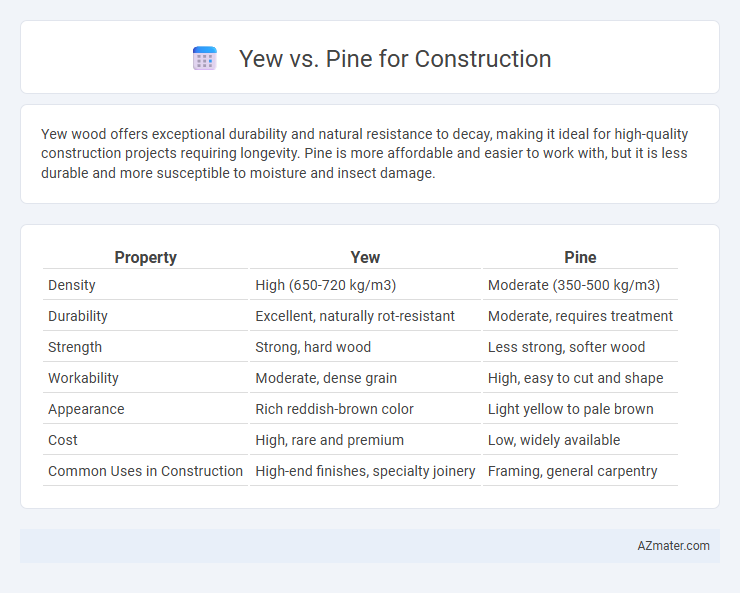Yew wood offers exceptional durability and natural resistance to decay, making it ideal for high-quality construction projects requiring longevity. Pine is more affordable and easier to work with, but it is less durable and more susceptible to moisture and insect damage.
Table of Comparison
| Property | Yew | Pine |
|---|---|---|
| Density | High (650-720 kg/m3) | Moderate (350-500 kg/m3) |
| Durability | Excellent, naturally rot-resistant | Moderate, requires treatment |
| Strength | Strong, hard wood | Less strong, softer wood |
| Workability | Moderate, dense grain | High, easy to cut and shape |
| Appearance | Rich reddish-brown color | Light yellow to pale brown |
| Cost | High, rare and premium | Low, widely available |
| Common Uses in Construction | High-end finishes, specialty joinery | Framing, general carpentry |
Introduction to Yew and Pine in Construction
Yew (Taxus species) and Pine (Pinus species) wood are commonly utilized in construction for their distinct properties and durability. Yew wood is valued for its fine grain, high density, and natural resistance to decay, making it suitable for furniture, interior paneling, and decorative elements. Pine wood, known for its versatility, lightweight nature, and ease of workability, is widely used in framing, roofing, and structural applications due to its strength-to-weight ratio and cost-effectiveness.
Botanical Overview: Yew vs Pine
Yew trees (Taxus spp.) are evergreen conifers characterized by dense, fine-grained wood with high elasticity and natural resistance to decay, making them suitable for specialized construction uses such as joinery and ornamental detailing. Pine species (Pinus spp.) offer fast-growing softwood with a more open grain structure, widely used in general construction for framing, flooring, and paneling due to its availability and cost-effectiveness. Botanically, yews belong to the Taxaceae family, thriving in shaded environments, while pines are part of the Pinaceae family, adapted to a variety of climates with a tolerance for poor soils.
Strength and Durability Comparison
Yew wood offers exceptional strength and durability, characterized by its dense grain and natural resistance to decay, making it suitable for high-stress structural applications. Pine, while more commonly used in construction due to its availability and cost-effectiveness, is softer and less durable, requiring treatment to withstand environmental factors and load-bearing demands. The higher density and natural oils in yew result in superior longevity and resistance to wear compared to the more porous and lightweight pine.
Workability and Machinability
Yew wood offers superior machinability due to its fine grain and uniform texture, allowing for precise cuts and smooth finishes in construction projects. Pine, while softer and easier to work with hand tools, tends to splinter and dent more easily, making it less ideal for detailed machining. The natural resilience and stability of yew wood contribute to its excellent workability, especially for intricate joinery and durable structural elements.
Resistance to Decay and Insects
Yew wood exhibits superior natural resistance to decay and insect infestation compared to pine, making it a preferred choice for long-lasting construction projects. Pine, while more readily available and affordable, typically requires chemical treatment to enhance its durability against rot and pests. The inherent durability of yew reduces maintenance costs and extends the lifespan of structural elements in outdoor environments.
Cost and Availability in the Market
Yew wood is significantly more expensive and less readily available than pine due to its slower growth rate and limited commercial supply, making it a rare choice for cost-sensitive construction projects. Pine is widely available, affordable, and commonly used in the construction industry because of its fast growth and abundant supply. For large-scale building applications where budget and accessibility are priorities, pine remains the dominant and economical option.
Environmental Impact and Sustainability
Yew wood offers a lower environmental impact due to its slower growth rate and greater carbon storage capacity compared to pine, which grows faster but often requires intensive plantation management that can disrupt local ecosystems. Pine's rapid regrowth supports renewable sourcing but may involve monoculture plantations that reduce biodiversity and soil quality over time. Choosing yew enhances long-term carbon sequestration and durability, while pine provides a more readily renewable option with potential environmental trade-offs depending on forestry practices.
Common Applications in Construction
Yew wood, known for its durability and resistance to decay, is commonly used in fine woodworking, furniture making, and decorative interior elements in construction. Pine, characterized by its affordability, ease of workability, and availability, is widely applied in framing, flooring, roofing, and structural supports. Both woods serve critical roles in construction, with yew favored for aesthetic and durable applications and pine chosen for structural efficiency and cost-effectiveness.
Aesthetic Differences: Grain and Color
Yew wood features a fine, smooth grain with rich, reddish-brown hues that deepen with age, offering a warm and elegant aesthetic ideal for high-end construction projects. Pine wood exhibits a more pronounced grain pattern with lighter colors ranging from pale yellow to light brown, providing a rustic and natural appearance suitable for casual or traditional builds. The distinct grain tightness and color variations between yew and pine influence their visual impact in architectural applications, with yew's refined texture contrasting sharply with pine's pronounced knots and lighter tones.
Choosing the Right Wood: Yew or Pine?
Yew wood offers exceptional durability and resistance to moisture, making it suitable for high-quality furniture and intricate woodwork in construction, while pine provides affordability, ease of workability, and quicker availability, ideal for framing and general structural use. The density of yew contributes to its strength and longevity, but its slower growth rate results in higher costs compared to the fast-growing, lighter pine. Selecting between yew and pine depends on project requirements for durability, aesthetic appeal, budget constraints, and the intended use in construction.

Infographic: Yew vs Pine for Construction
 azmater.com
azmater.com